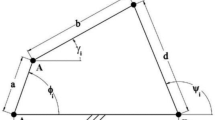Abstract
A method for structural topology optimization of frame structures with flexible joints is presented. A typical frame structure is a set of beams and joints assembled to carry an applied load. The problem considered in this paper is to find the stiffest frame for a given mass. By introducing design variables for beams and joints, a mass distribution for optimal structural stiffness can be found. Each beam can have several design variables connected to its cross section. One of these is an area-type design variable which is used to represent the global size of the beam. The other design variables are of length ratio type, controlling the cross section of the beam. Joints are flexible elements connecting the beams in the structure. Each joint has stiffness properties and a mass. A framework for modelling these stiffnesses is presented and design variables for joints are introduced. We prove a theorem which can be interpreted as the fact that the removal of structural elements, e.g. joints or beams, can be modelled by a small strictly positive material amount assigned to the element. This is needed for the computations of sensitivities used in the applied gradient based iterative method. Both two and three dimensional problems, as well as multiple load cases and multiple mass constraints, are treated.
Similar content being viewed by others
References
Achtziger, W. 1998: Multiple-load truss topology and sizing optimization: Some properties of minimax compliance. J. Optim. Theory Appl. 98, 255–280
Achtziger, W. 1999: Local stability of trusses in the context of topology optimization Part I: Exact modelling. Struct. Optim. 17, 235–246
Argyris, J.H.; Balmer, H.; Doltsinis, J.St.; Dunne, P.C.; Haase, M.; Kleiber, M.; Malejannakis, G.A.; Mlejnek, H.-P.; Müller, M.; Scharpf, D.W. 1979: Finite element method – The natural approach. Comput. Methods Appl. Mech. Eng. 17/18, 1–106
Aubin, J.-P.; Frankowska, H. 1990: Set-Valued Analysis. Boston: Birkhäuser
Bazaraa, M.S.; Sherali, H.D.; Shetty, C.M. 1993: Nonlinear Programming: Theory and Algorithms. New York: John Wiley and Sons
Bendsøe, M.P. 1995: Optimization of Structural Topology, Shape, and Material. Berlin, Heidelberg, New York: Springer-Verlag
Bendsøe, M.P.; Ben-Tal, A.; Zowe, J. 1994: Optimization methods for truss geometry and topology design. Struct. Optim. 7, 141–159
Cameron, T.M.; Thirunavukarasu, A.C.; El-Sayed, M.E.M. 2000: Optimization of frame structures with flexible joints. Struct. Multidisc. Optim. 19, 204–213
Cheng, G.D.; Guo, X. 1997: ε-relaxed approach in structural topology optimization. Struct. Optim. 13, 258–266
Daniel, J.W. 1973: Stability of the solution of definite quadratic programs. Math. Program. 5, 41–53
Eschenauer, H.A.; Olhoff, N. 2001: Topology optimization of continuum structures: A review. Appl. Mech. Rev. 54, 331–390
Fredricson, H. 2002: Optimization methods for vehicle body structures. Int. Rep. LIU-TEK-LIC, 2002: 24 Dept. Mech. Eng., Linköping University
Jivotovski, G. 2000: A gradient based heuristic algorithm and its application to discrete optimization of bar structures. Struct. Multidisc. Optim. 19, 237–248
Jonsson, D.; Johansen, T. 1997: Conceptual design of a gearbox housing using topology optimization. Thesis work carried out at Volvo Technological Development, Int. Rep. LiTH–IKP–EX–1447, Dept. Mech. Eng., Linköping University
Memari, A.M.; Madhkan, M. 1999: Optimal design of steel frames subject to gravity and seismic codes’ prescribed lateral forces. Struct. Optim. 18, 56–66
Nishigaki, H.; Nishiwaki, S.; Amago, T.; Kojima, Y.; Kikuchi, N. 2001: First order analysis – new CAE tools for automotive body designers. SAE Paper, No. 2001-01-0768
Sergeyev, O.; Pedersen, P. 1996: On design of joint positions for minimum mass 3D frames. Struct. Optim. 11, 95–101
Sergeyev, O.; Mroz, Z. 1998: Optimal joint positions and stiffness distribution for minimum mass frames with damping constraints. Struct. Multidisc. Optim. 16, 231–245
Svanberg, K. 1987: The method of moving asymptotes – a new method for structural optimization. Int. J. Numer. Methods Eng. 24, 359–373
Author information
Authors and Affiliations
Corresponding author
Rights and permissions
About this article
Cite this article
Fredricson , H., Johansen , T., Klarbring , A. et al. Topology optimization of frame structures with flexible joints. Struct Multidisc Optim 25, 199–214 (2003). https://doi.org/10.1007/s00158-003-0281-z
Received:
Revised:
Published:
Issue Date:
DOI: https://doi.org/10.1007/s00158-003-0281-z




